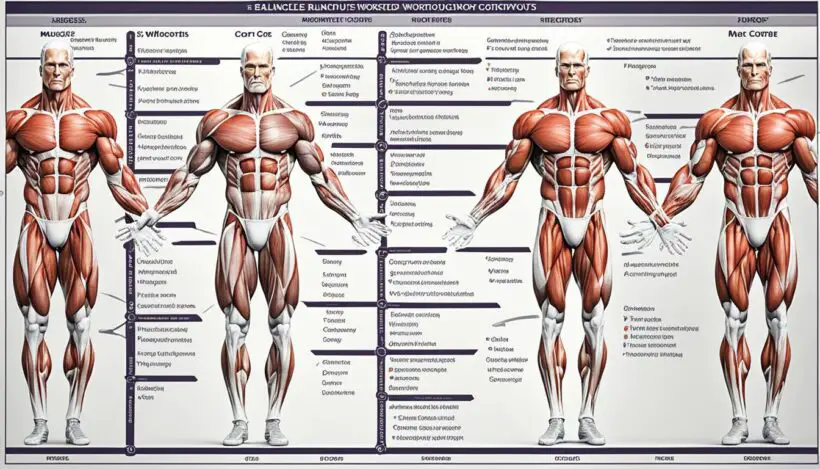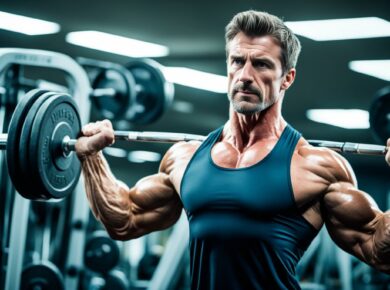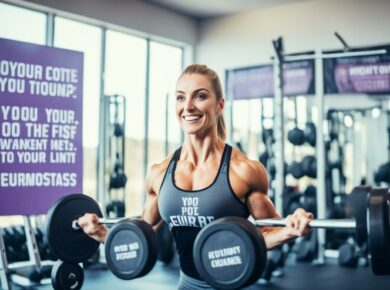Understanding the major muscle groups in your body is essential for creating a balanced strength training routine. Pairing certain muscle groups together can make your workouts more efficient and help prevent overtraining. Regular strength training improves bone, muscle, and connective tissue health, while also boosting metabolism. There are three types of muscles in the body: cardiac, smooth, and skeletal. The major muscle groups include the chest, back, arms, abdominals, legs, and shoulders. Other specific categories include calves, hamstrings, quadriceps, glutes, biceps, triceps, forearms, trapezius, and latissimus dorsi.
In this article, we will explore different muscle groups, their functions, and exercises that target them. We will also discuss the benefits of cross-training and provide tips for effective muscle group training. Whether you’re a beginner or an advanced lifter, understanding muscle anatomy and incorporating targeted exercises into your fitness routine is crucial for achieving your desired fitness goals.
Understanding Muscle Group Functions and Exercises
Each muscle group in the body has specific functions and corresponding exercises that target those muscles. By understanding the functions of different muscle groups, you can tailor your workouts to effectively train and strengthen specific areas of your body.
Chest Muscles
The chest muscles, also known as the pectoralis major and minor, are responsible for pushing movements. Exercises such as bench press and push-ups directly target and strengthen the chest muscles, helping to develop a more defined and sculpted upper body.
Back Muscles
The back muscles play a crucial role in pulling movements. The trapezius, rhomboids, and latissimus dorsi are key muscle groups in the back. Exercises like rows and pull-ups work these muscles, helping to improve posture, strengthen the upper back, and promote a balanced physique.
Arm Muscles
The arms consist of two main muscle groups: the biceps and triceps. The biceps are responsible for flexing the elbow, while the triceps are responsible for extending the elbow. Curls and dips target the biceps and triceps respectively, aiding in the development of strong and toned arms.
Leg Muscles
The legs are essential for lower body movements and consist of several muscle groups, including the quadriceps, hamstrings, and calves. Squats and lunges are popular exercises that engage these muscle groups, helping to build strength and endurance in the lower body.
Shoulder Muscles
The shoulders are involved in various upper body movements and play a significant role in overall upper body strength. Shoulder presses and lateral raises are effective exercises that target the deltoids, helping to develop well-rounded shoulder muscles and improve overall upper body strength.
Understanding the functions of each muscle group and incorporating the appropriate exercises into your workout routine can help you achieve balanced muscle development and maximize your strength training results.
Pairing Muscle Groups for Optimal Results
When it comes to maximizing your workouts, pairing the right muscle groups together can make a significant difference. While there is no one-size-fits-all approach, many fitness enthusiasts find it beneficial to pair muscles that are close together in order to create synergistic movements and engage multiple muscle groups simultaneously.
For example, combining exercises that target the shoulders and arms can be highly effective since many movements, such as rows, involve both of these muscle groups. By working them together, you can achieve a more comprehensive upper body workout.
Another strategy is splitting different muscle groups onto different days, allowing for more rest and recovery between workouts. This can be particularly useful if you have specific areas you want to prioritize or if you find that certain muscle groups need extra attention.
Here are some examples of effective muscle group combinations:
- Chest and shoulders: By working these two muscle groups together, you can create a powerful upper body routine that targets your chest, shoulders, and triceps.
- Legs and back: Pairing the legs and back allows you to focus on powerful lower body movements like squats and deadlifts, while also engaging the muscles in your back.
- Abdominals and arms: Combining exercises for your abs and arms can help you develop strong core stability and sculpted arms simultaneously.
If you’re just starting out, it’s recommended to begin with these six basic muscle groups. As you progress, you can fine-tune your training program and explore more detailed muscle group combinations.
Example: Advanced Muscle Group Splits
- Chest, shoulders, triceps, and forearms: This combination targets the entire upper body, helping you build strength and definition.
- Calves, hamstrings, quadriceps, and glutes: Focusing on the lower body, this split emphasizes powerful leg movements for enhanced lower body strength and stability.
- Biceps, back, abdominals, traps, and lats: This combination provides a comprehensive workout for your arms, back, and core, allowing you to develop a balanced and well-rounded physique.
Remember to listen to your body and adjust your training program accordingly. Whether you choose to pair muscle groups or follow a more detailed split, the key is to find a routine that challenges you, provides proper rest and recovery, and helps you achieve your fitness goals.
Structuring Your Weekly Workout Schedule
To optimize your strength training and give each muscle group sufficient rest and recovery time, it is important to structure your weekly workout schedule. The American Heart Association recommends engaging in strength training at least two days per week for optimal health. By planning your training sessions throughout the week, you can ensure that you are working different muscle groups on different days.
Here are a few examples of weekly workout schedules:
- Day 1: Focus on chest and shoulders. Include exercises like bench press, dumbbell shoulder presses, and lateral raises.
- Day 2: Target your legs with exercises like squats, lunges, and calf raises.
- Day 3: Work on your back, abdominals, and arms. Incorporate exercises like rows, planks, and bicep curls.
Alternatively, if you prefer a two-day split, you can structure your workouts as follows:
- Day 1: Target your chest, arms, and shoulders. Include exercises like push-ups, tricep dips, and military presses.
- Day 2: Focus on your legs, back, and abdominals. Incorporate exercises like deadlifts, pull-ups, and crunches.
Listening to your body and adjusting your schedule as needed is crucial. It is important to take rest days to allow your muscles to recover and prevent overtraining. Rest days help prevent burnout and reduce the risk of injuries. Remember, consistency is key to achieving your fitness goals.
Different Types of Exercises for Muscle Groups
When it comes to strengthening your muscle groups, there are various types of exercises you can incorporate into your fitness routine. Whether you prefer using equipment or just your bodyweight, there are options to suit every preference and fitness level.
Resistance Band Exercises
Resistance bands are versatile and portable, making them a great option for muscle group exercises. You can target different muscle groups by using bands of varying resistance levels. Exercises like banded squats, lateral band walks, and seated rows can help you strengthen and tone your muscles.
Medicine Ball Exercises
A medicine ball is an effective tool for adding resistance to your workouts. It can be used for exercises like medicine ball slams, Russian twists, and wall balls, which engage multiple muscle groups and improve overall strength and coordination.
Free Weights
Free weights, such as dumbbells and barbells, provide an excellent way to challenge your muscles and build strength. Examples of free weight exercises include dumbbell curls, barbell squats, and chest presses. Start with weights that allow you to complete 12 to 15 repetitions with good form, gradually increasing the weight as you progress.
Machine Exercises
Gym machines are designed to target specific muscle groups and offer stability and control during exercises. They can be especially beneficial for beginners or individuals recovering from an injury. Leg press machines, lat pulldowns, and chest fly machines are common examples of exercises that can be done using gym equipment.
Bodyweight Exercises
Bodyweight exercises are a convenient and effective way to work all major muscle groups. They require no equipment and can be done anywhere. Examples of bodyweight exercises include push-ups, squats, lunges, and planks, which engage multiple muscle groups and improve strength and stability.
Remember to choose exercises that target each muscle group adequately and maintain proper form to avoid injury. Incorporating a combination of the above exercises into your workout routine will help ensure balanced muscle development and overall fitness.
Targeted Exercises for Each Muscle Group
To effectively train and strengthen each major muscle group, it’s important to incorporate targeted exercises into your workout routine. By focusing on specific muscles, you can maximize your gains and achieve a balanced physique. Here are some exercises for each muscle group:
Chest Exercises
- Bench press
- Push-ups
- Chest flyes
Back Exercises
- One-arm dumbbell rows
- Resistance band pull-aparts
- Lat pulldowns
Arm Exercises
- Bicep curls
- Tricep dips
- Hammer curls
Abdominal Exercises
- Planks
- Bicycle crunches
- Leg raises
Leg Exercises
- Squats
- Lunges
- Deadlifts
Shoulder Exercises
- Seated shoulder press
- Resistance band shoulder press
- Lateral raises
It’s crucial to choose exercises that adequately target each muscle group and maintain proper form throughout your workout. Remember to start with lighter weights and gradually increase the resistance as you become stronger. By incorporating these exercises into your routine, you can effectively train each muscle group and work towards your fitness goals.
The Benefits of Cross-Training for Muscle Groups
Cross-training is an effective way to enhance your fitness routine by incorporating different types of exercises. It offers numerous benefits for muscle groups, providing a well-rounded approach to your workouts.
One of the key advantages of cross-training is that it prevents burnout and boredom. By incorporating a variety of exercises into your routine, you can keep your workouts fresh and exciting.
Moreover, cross-training can help reduce the risk of injury. When you perform the same exercises repeatedly, you may put excessive strain on certain muscles and joints, leading to overuse injuries. By engaging in different activities, you allow those overworked muscles to rest while strengthening other muscle groups.
Cross-training also improves overall strength and endurance. By challenging different muscle groups in various ways, you can achieve a more balanced level of fitness. This not only helps you perform better in your workouts but also in your daily activities.
In addition to the physical benefits, cross-training provides mental stimulation. Trying new exercises and engaging in different activities can keep your mind engaged and prevent exercise monotony.
To enhance your performance and prevent muscle imbalances, it’s important to engage in a varied exercise routine. Cross-training ensures that all muscle groups are engaged and strengthened, reducing the risk of imbalances that can lead to injuries.
Overall, cross-training offers a range of benefits for muscle groups. It prevents burnout, reduces the risk of injury, improves strength and endurance, provides mental stimulation, and ensures balanced muscle development.
Best Cross-Training Exercises for Muscle Groups
When it comes to cross-training, there are plenty of exercises that can benefit your muscle groups. Whether you’re a cyclist, swimmer, or athlete, incorporating these exercises into your routine can help improve performance and prevent overuse injuries.
Exercises for Cyclists
If you’re a cyclist looking to enhance your muscular endurance, consider adding strength training exercises to your regimen. Squats and lunges are excellent options that target the lower body muscles, promoting strength and stability. Additionally, Pilates is a popular cross-training exercise for cyclists, as it improves flexibility and core strength, which are essential for maintaining proper form and preventing injuries.
Exercises for Swimmers
Swimmers can benefit from incorporating running, rowing, and cycling into their cross-training routine. These exercises help improve cardiovascular fitness and total body strength, complementing the demands of swimming. By engaging in these activities, swimmers can enhance their endurance and improve their overall performance in the water.
Exercises for Athletes
Athletes from various sports can benefit from a well-rounded cross-training routine. Incorporating a mix of exercises such as rowing, swimming, plyometrics, strength training, and yoga can target different muscle groups and enhance overall athletic performance. These exercises help build strength, improve flexibility, and prevent overuse injuries, making them valuable additions to any athlete’s training program.
By incorporating these cross-training exercises into your routine, you can maximize the benefits for your muscle groups. Whether you’re a cyclist, swimmer, or athlete, these exercises offer a well-rounded approach to training, improving strength, endurance, and overall fitness.
The Importance of Muscle Anatomy for Fitness
Understanding muscle anatomy is vital for creating a safe and effective exercise program. It plays a crucial role in preventing muscle imbalances, promoting balanced training, enhancing posture, preventing injuries, and achieving a well-rounded physique. Each muscle group in our body has specific functions and works together with other muscles to perform various movements and actions.
By targeting each muscle group appropriately and maintaining balance between them, you can improve overall strength, function, and aesthetics. Incorporating exercises that address all major muscle groups is essential for achieving optimal fitness and reducing the risk of imbalances that can lead to poor posture and injuries.
Muscle imbalances can occur when certain muscle groups are overdeveloped or underdeveloped compared to their counterparts. This can lead to poor posture, instability, and increased risk of injury. Understanding muscle anatomy allows you to design a training program that focuses on balancing the strength and development of different muscle groups, promoting optimal alignment and posture.
By incorporating exercises that target all major muscle groups, you ensure that each muscle group is adequately trained, leading to a well-rounded physique. Balanced training not only improves aesthetics but also enhances functional movement patterns, making daily activities easier and reducing the risk of muscle imbalances and injuries.
Injury Prevention through Muscle Anatomy
- Understanding muscle anatomy helps identify muscle imbalances and weaknesses that may lead to injuries during training.
- Training all major muscle groups equally ensures proper load distribution, reducing the risk of overloading or straining specific muscles.
- Addressing muscle imbalances through targeted exercises helps correct dysfunctional movement patterns and improves joint stability.
Improved Posture through Muscle Anatomy
- Muscle imbalances can lead to poor posture, such as rounded shoulders or anterior pelvic tilt.
- Targeting specific muscle groups through training can help realign posture and improve muscular balance.
- Exercises that strengthen the core and back muscles contribute to maintaining an upright posture and reducing the risk of postural imbalances.
Optimizing Training with Muscle Anatomy
- Understanding muscle anatomy helps in selecting appropriate exercises that effectively target specific muscle groups.
- By incorporating a variety of exercises that cover all major muscle groups, you ensure comprehensive and balanced muscle development.
- Focusing on specific muscle groups during training can help overcome plateaus and stimulate muscle growth.
In summary, understanding muscle anatomy is essential for designing an effective workout routine that promotes balanced training, prevents injuries, improves posture, and enhances overall physique. By incorporating exercises that target all major muscle groups, you can achieve optimal fitness and reduce the risk of imbalances that can lead to poor posture and injuries.
Tips for Effective Muscle Group Training
To get the most out of your muscle group training, it’s important to follow some tips for effectiveness. By incorporating these strategies into your workouts, you can optimize your training and achieve your desired fitness goals.
- Progressive Overload: Gradually increase the intensity and resistance of your workouts over time. This helps to challenge your muscles and stimulate growth. Adding more weight, increasing repetitions, or decreasing rest time are all effective ways to implement progressive overload. Remember to listen to your body and progress at a pace that feels comfortable for you.
- Proper Form: Pay close attention to your form during exercises to maximize muscle engagement and prevent injuries. Maintain proper alignment, control your movements, and focus on the targeted muscle group. It can be helpful to work with a qualified trainer or watch instructional videos to ensure you are performing exercises correctly.
- Recovery and Rest: Allow for adequate recovery and rest between workouts. This is when your muscles repair and grow stronger. Aim for at least 48 hours of rest between training sessions that target the same muscle group. Remember that rest days are just as important as workout days for optimal muscle development.
- Consistency: Stick to a regular training schedule and make muscle group training a consistent part of your overall fitness routine. Consistency is key to seeing results and making progress. Aim for a balanced approach that targets all major muscle groups throughout the week.
By following these tips for effective muscle group training, you can ensure that you are making the most of your workouts and achieving your fitness goals. Remember to listen to your body, adjust as needed, and stay committed to your training routine. 
Conclusion
Incorporating muscle group training into your fitness routine is crucial for achieving overall fitness and balanced workouts. Understanding muscle anatomy and the functions of each major muscle group is key to creating effective and safe exercise programs.
Cross-training is an excellent way to enhance your performance, prevent injuries, and add variety and mental stimulation to your workouts. By including different types of exercises and targeting various muscle groups, you can optimize your training and achieve your fitness goals.
To make the most of your muscle group training, remember to follow effective training tips such as progressive overload, maintaining proper form, and allowing for adequate rest and recovery. Consistency is also important, so aim to maintain a regular training schedule.
By incorporating these strategies into your muscle group training, you can ensure that your workouts are well-rounded, safe, and effective, leading to improved strength, endurance, and overall fitness.






